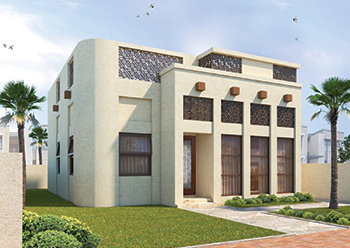
The 3D Studio 2030 Project .. a world-first project conducted jointly by CyBe and contractor Consolidated Contractors Company (CCC) in Saudi Arabia.
Sharjah to shape first 3D printed home with CyBe
01 September 2019
The UAE emirate of Sharjah is well on its way to establishing itself as a frontrunner in adopting technology that shapes the architecture of the future with plans to 3D print its first house by the Q3 of this year.
In line with the trends in the global construction sector, Sharjah Research, Technology and Innovation Park (SRTI Park) has teamed up with renowned local and global organisations to 3D print the emirate’s first house in the park. Production work on the house is expected to start soon.
The project comes as a result of a triple helix collaboration of government, private, and academia, where CyBe Construction from the Netherlands is providing the 3D printing technology, and the American University of Sharjah (AUS) will be supporting with research and talent.
 |
|
A concept of the 3D printed house at Sharjah’s SRTI Park. |
In an interview with Gulf Construction’s ABDULAZIZ KHATTAK, Berry Hendriks, the CEO and founder of CyBe, says the printing of the house will take one to two weeks including training.
Hendriks points out that by introducing 3D printing, SRTI Park is creating a proactive and supportive environment for experiments and research in the field of future building and fourth-generation technologies.
“The technology is considered to be one of the most innovative and reliable to build an integrated residential unit through the use of digital machineries. Additionally, the technology is also expected to reduce the costs of collection, transport and construction.”
Hussain Al Mahmoudi, the CEO of SRTI Park, says they are delighted to launch this ambitious project, which translates the vision of the park and its ambitious strategy to introduce all kinds of reliable future technologies to serve and facilitate people.
He says the project comes at a time when the cost of traditional construction is increasing. “This type of construction has many advantages such as easy access to complex designs and simple modification with access to parts of different sizes, which results in speedy implementation and lower cost,” he adds.
The team implementing the project will consist of employees of Sharjah-based Ginco Contracting, together with students from AUS’s Faculty of Engineering, who will get hands-on training in this technique.
The building will consist of 35 elements – 26 walls and nine parapets. These elements will be printed on site one after the other. The internal reinforced structure in compliance with the local regulations will be used to build the top floor.
The printer used for the project is the CyBe RC 3DP – a mobile model designed for on-site printing. The robotic arm of the printer is placed on tracks.
Commenting on feeding the material into the printer, Hendriks says the printing material will be first mixed in the mix-pump system. A hose, connected both to this system and the printer, then carries the mixture to the nozzle. The material is then sprayed at the spot where it’s needed based on the 3D model, which has been loaded into the printer software.
The curing time for the mixture depends on the outside temperature and humidity, he adds.
Comparing 3D printing construction to conventional methods, Hendriks says the former can reduce cost by 20-30 per cent, for example, for a comparable project in the Netherlands.
This percentage can, however, differ from country to country depending on the local economy, building regulations, and building requirements, he points out.
Besides printing projects for its customers/partners, CyBE also sells its 3D concrete printers to its partners. It usually trains them on the job during a first project. After receiving the print operator certificate, they can then print projects on their own and start mass production.
- BMC Gulf to floor market with ‘concrete on a roll’
- RMDK tells how to boost productivity
- Sharjah to shape first 3D printed home with CyBe
- Meva systems help shape residential tower
- Ori furniture brings dream homes to tight spaces


